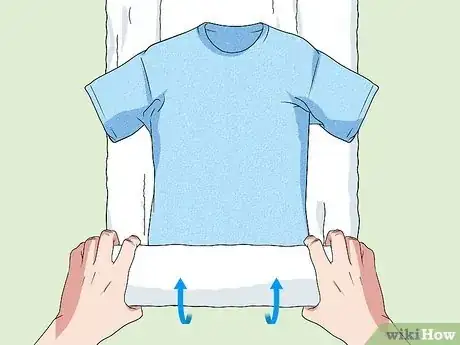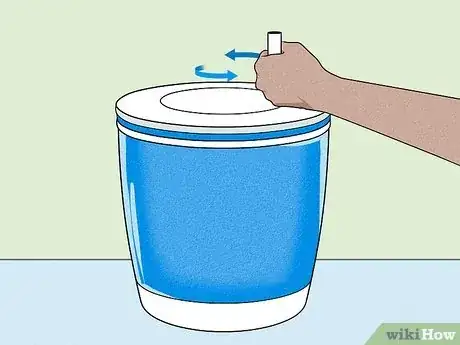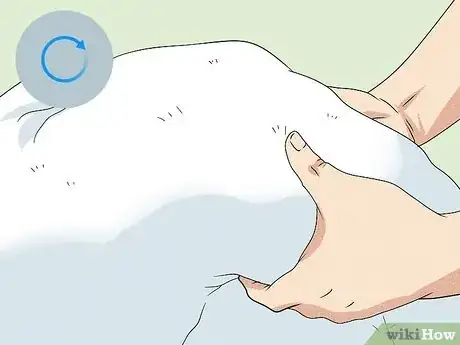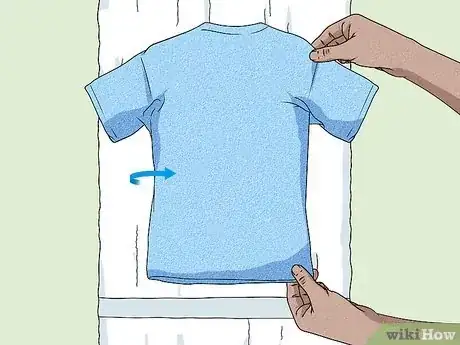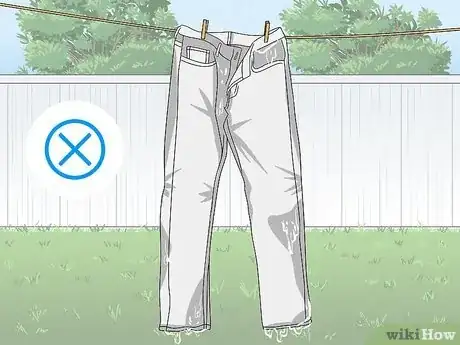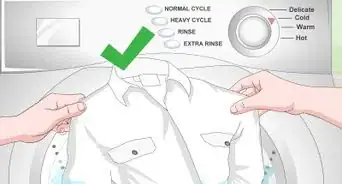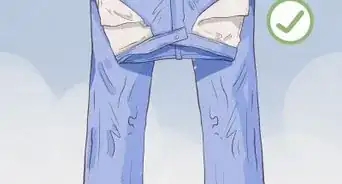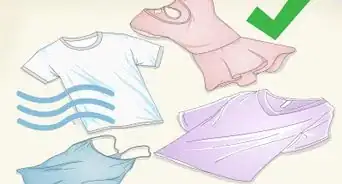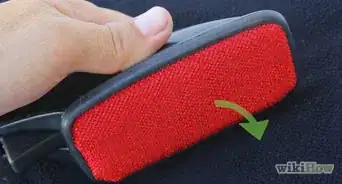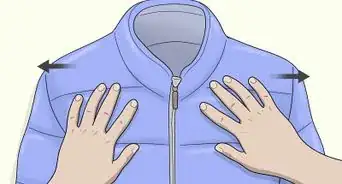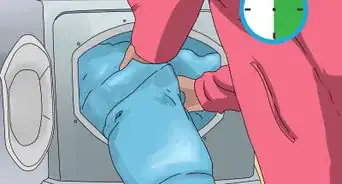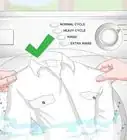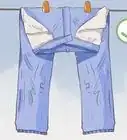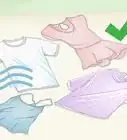This article was co-authored by Ayad Mirjan and by wikiHow staff writer, Hannah Madden. Ayad Mirjan is a Dry Cleaner and Laundry Specialist and the Founder of OrangeBag®, a toxin-free, sustainable, Los Angeles-based laundry and dry cleaning delivery service. Ayad has over four years of experience in the industry and he specializes in providing easy laundry and dry-cleaning solutions to professionals, families, and businesses. Ayad received his Bachelor's degree from The University of California, San Diego, and an MBA from Henley Business School. He is also a board member of the Entrepreneur's Organization Accelerator (EOA).
There are 8 references cited in this article, which can be found at the bottom of the page.
This article has been viewed 49,634 times.
You’ve washed all your clothing by hand, taking extra care to be gentle—now, how do you dry it? Drying your clothing the right way helps it stay wrinkle-free once it’s clean. Read through this article to learn how to remove any excess water, then lay heavy items flat to dry or hang up smaller items.
Things You Should Know
- Squeeze any excess water out of your clothing when you’re done washing it. Then, roll the item in a towel to remove more water.
- Use a manual laundry spinner to remove almost all moisture from your clothing.
- Lay heavy items, like sweaters and dresses, flat on a towel to air dry.
- Hang smaller items, like T-shirts, on a clothing rack or clothesline.
Steps
Removing Excess Water
-
1Squeeze excess water out of the clothing. When you’re done washing by hand, pick up the garment and gently squeeze it into your water tub or sink. Try not to wring or twist it, since that can damage the fibers of your clothing.[1]
- Always work with one garment at a time.
-
2Lay a clean towel on a flat surface. Clear out space on a flat surface, such as on a countertop, tile flooring, or in the bathtub. Choose a white towel to eliminate the chance of color bleeding and make sure it’s freshly washed so it doesn’t leave annoying lint on your clothing.[2]Advertisement
-
3Roll the towel to squeeze more water out of the clothing. Spread your clothing item flat onto the towel. Then, starting at one end of the towel, roll it over and onto the clothing. Gently press down on the towel roll to squeeze out as much water as possible.[3]
- If you’re washing smaller garments, like underwear or socks, do a few items at a time. For larger clothing, like shirts or dresses, stick to 1 item per towel.
-
4Use a manual laundry spinner to remove almost all moisture. Manual laundry spinners don’t use electricity, so they’re perfect for off-the-grid living. Simply place 1 large garment or 2 small garments inside the spinner, then close the lid. Point the tube at the bottom toward the ground, then use the handle on top to spin your laundry.[4]
- The excess water will pour out of the tube at the bottom of the spinner. When no more water comes out, you know your clothing is ready to go.
- Laundry spinners won’t dry your clothes completely, but they cut down on drying time immensely.
Laying Clothing Flat to Dry
-
1Look for a flat surface in open air. Any piece of clothing can finish drying in a spot where air circulates. This could be on a countertop, tile floor, or the bottom of a bathtub. The more out in the open the spot is, the faster the clothing will dry.[5]
- Sunlight will speed up the drying process, but it can also fade and damage fabric. If you’re going to dry your clothing outside, pick a shady area out of direct sunlight.
-
2Flatten large clothing on a clean towel. Spread a clean, white towel out, then flatten out your garment. Make sure it isn’t folded or creased, since that could leave wrinkles.[6]
- Laying clothing flat to dry is great for delicate items, like sweaters and dresses.
- Heavy fabrics, like wool, denim, canvas, and corduroy dry best laying flat. Try not to hang those items up, as it can stretch or warp them.
- To speed up the drying process, consider investing in a flat drying rack. The open air underneath your clothing will make everything dry faster.
-
3Replace the towel when it feels wet. Clothing dries much faster on a clean, dry surface. Check on your garments every hour or so and feel the towel underneath them, and swap it out if needed.[7]
-
4Flip the clothing halfway through the drying time. For thick, heavy garments, flipping them over will speed up the drying time. After about 2 to 4 hours, head over to your clothing and flip it over to the other side.[8]
- Pat your clothing flat again to keep it from wrinkling as it dries.
- Thick, heavy garments, like wool sweaters, may need to dry for as long as 24 hours.
Hanging Clothing to Dry
-
1Hang clothes on a clothing rack to dry them indoors. Clothing racks are perfect for hanging up clothing in small spaces. Get a clothing rack and set it up in your home, then spread the wet clothing over the rungs of the rack. Make sure that the garments don’t overlap to dry your clothes quickly.[9]
- To speed up indoor drying, point a fan at your clothing.
- Try to hang-dry your clothes overnight.
-
2Use a clothesline to dry clothes outside. A clothesline is a great way to dry large items, like sheets, towels, and blankets. String up a clothesline outside and use clothespins to spread your garments out on the line. Make sure to check the weather, since a burst of rain could ruin your clothing’s chances of drying fast.[10]
- Avoid hanging delicates or anything heavy, like wool, on a clothesline.
- Keep your clothesline out of direct sunlight to prevent fading.
-
3Avoid hanging heavy items to prevent stretching. Water and gravity will pull down and stretch any clothing you hang vertically. This can turn heavy clothing, like a precious knit sweater, into a misshapen article that no longer fits. When in doubt, dry your clothing on a flat surface.[11]
Expert Q&A
-
QuestionHow do you air-dry clothes in high humidity?
 Ayad MirjanAyad Mirjan is a Dry Cleaner and Laundry Specialist and the Founder of OrangeBag®, a toxin-free, sustainable, Los Angeles-based laundry and dry cleaning delivery service. Ayad has over four years of experience in the industry and he specializes in providing easy laundry and dry-cleaning solutions to professionals, families, and businesses. Ayad received his Bachelor's degree from The University of California, San Diego, and an MBA from Henley Business School. He is also a board member of the Entrepreneur's Organization Accelerator (EOA).
Ayad MirjanAyad Mirjan is a Dry Cleaner and Laundry Specialist and the Founder of OrangeBag®, a toxin-free, sustainable, Los Angeles-based laundry and dry cleaning delivery service. Ayad has over four years of experience in the industry and he specializes in providing easy laundry and dry-cleaning solutions to professionals, families, and businesses. Ayad received his Bachelor's degree from The University of California, San Diego, and an MBA from Henley Business School. He is also a board member of the Entrepreneur's Organization Accelerator (EOA).
Dry Cleaner & Laundry Specialist Hang your clothes on a clothing rack in a well-ventilated room. If you have a ceiling fan, place your clothes immediately underneath the fan, ensuring that that the garments are separated and not layered on top of one another. A floor fan can work as well if you rotate the clothing rack to ensure even drying.
Hang your clothes on a clothing rack in a well-ventilated room. If you have a ceiling fan, place your clothes immediately underneath the fan, ensuring that that the garments are separated and not layered on top of one another. A floor fan can work as well if you rotate the clothing rack to ensure even drying. -
QuestionWhen hanging a dress with patch pockets, how do you keep pockets from sagging?
 wikiHow Staff EditorThis answer was written by one of our trained team of researchers who validated it for accuracy and comprehensiveness.
wikiHow Staff EditorThis answer was written by one of our trained team of researchers who validated it for accuracy and comprehensiveness.
Staff Answer wikiHow Staff EditorStaff AnswerIf you're worried about sagging, try laying the garment flat instead of hanging it up. That way, there's no chance that the pockets will hang and sag or create wrinkles.
wikiHow Staff EditorStaff AnswerIf you're worried about sagging, try laying the garment flat instead of hanging it up. That way, there's no chance that the pockets will hang and sag or create wrinkles.
References
- ↑ https://www.bobvila.com/articles/how-to-hand-wash-clothes/
- ↑ https://www.youtube.com/watch?v=Ay6oOkvM_A8&t=389s
- ↑ https://www.youtube.com/watch?v=Ay6oOkvM_A8&t=397s
- ↑ https://www.youtube.com/watch?v=zYNt_rY2mCI&t=460s
- ↑ https://www.bobvila.com/slideshow/the-dos-and-don-ts-of-air-drying-everything-you-own-52998
- ↑ https://www.youtube.com/watch?v=y6VpqAWkWCw&t=91s
- ↑ https://www.bobvila.com/slideshow/the-dos-and-don-ts-of-air-drying-everything-you-own-52998
- ↑ https://www.youtube.com/watch?v=0DUs0GnkehU&t=42s
- ↑ https://www.bobvila.com/slideshow/the-dos-and-don-ts-of-air-drying-everything-you-own-52998


